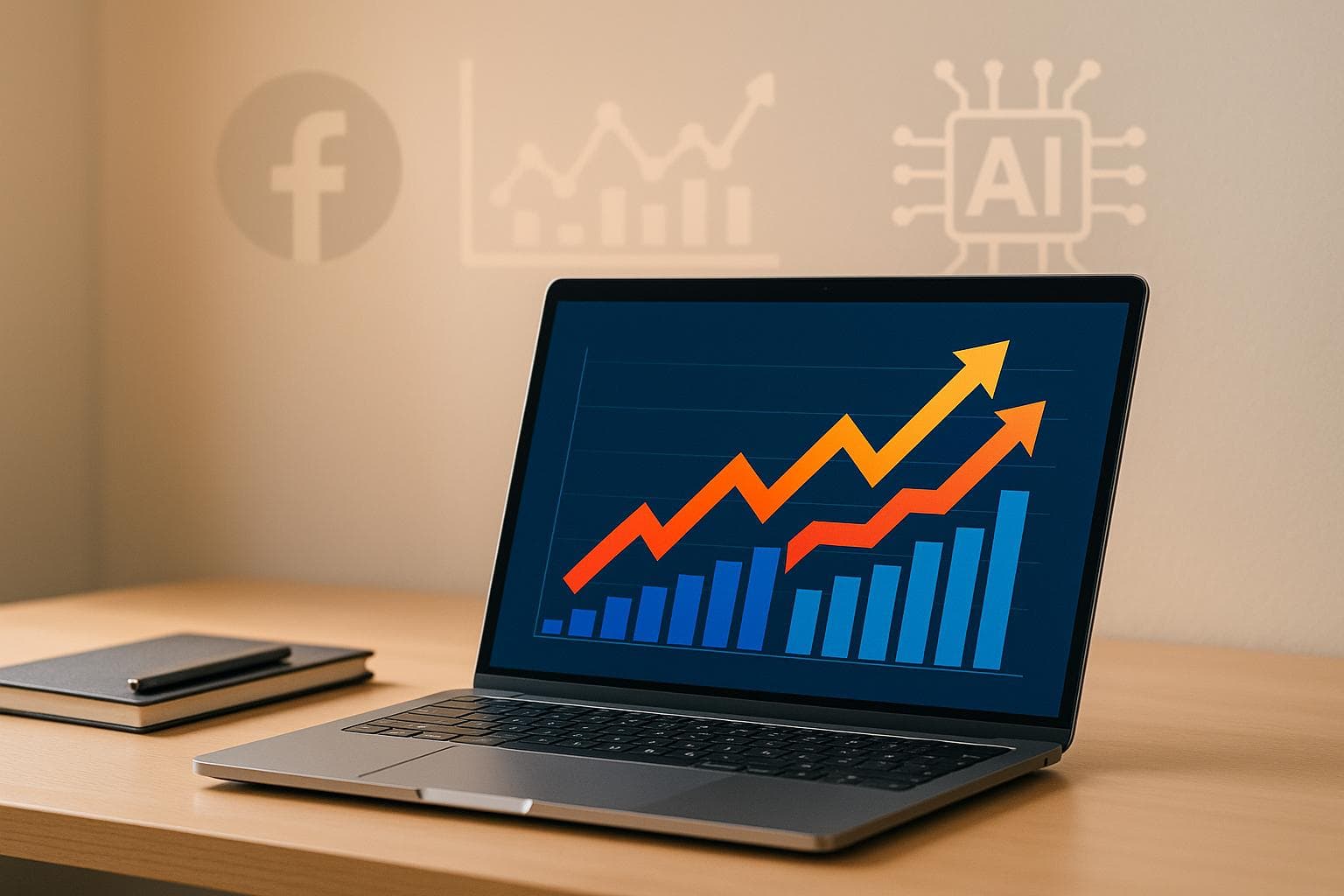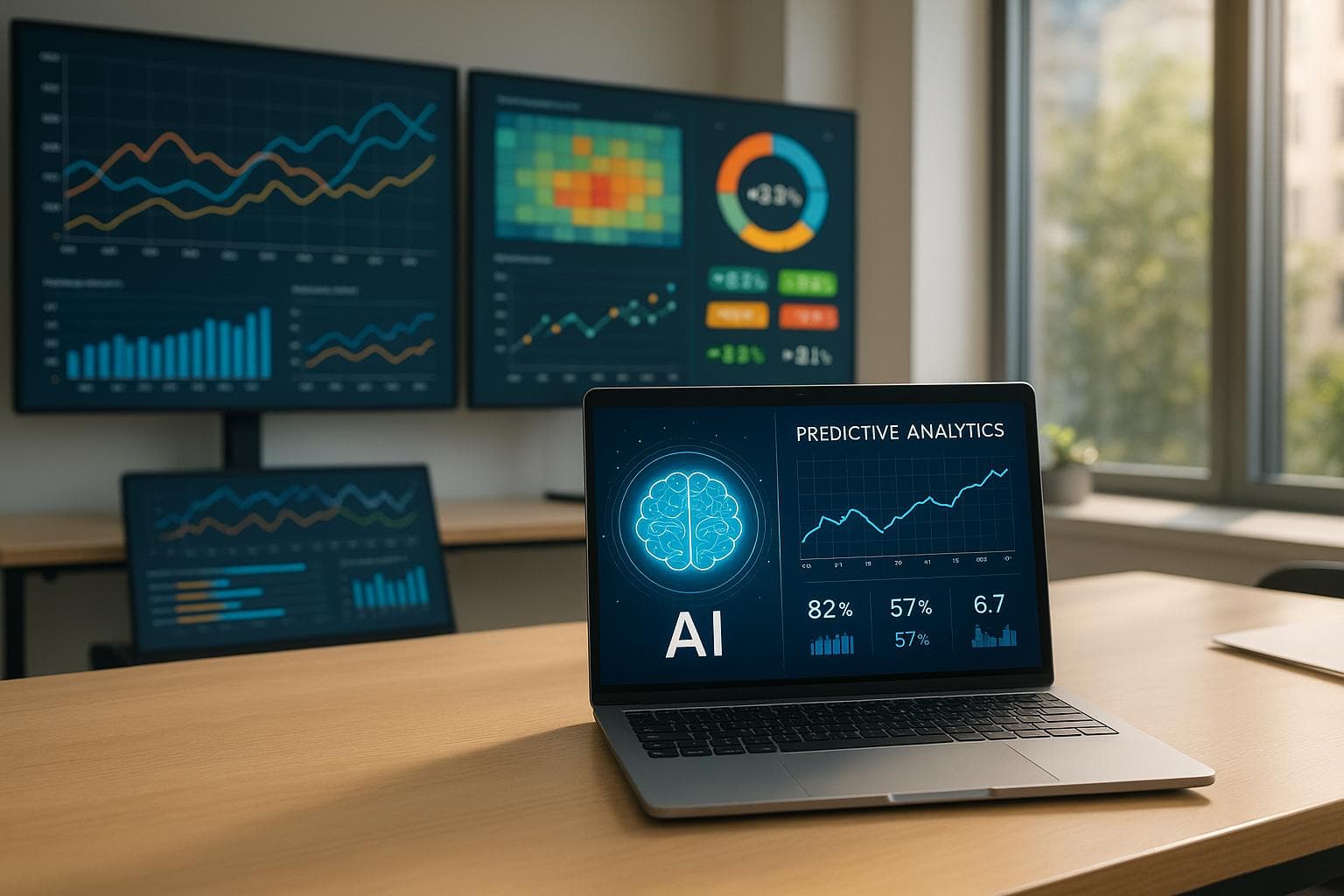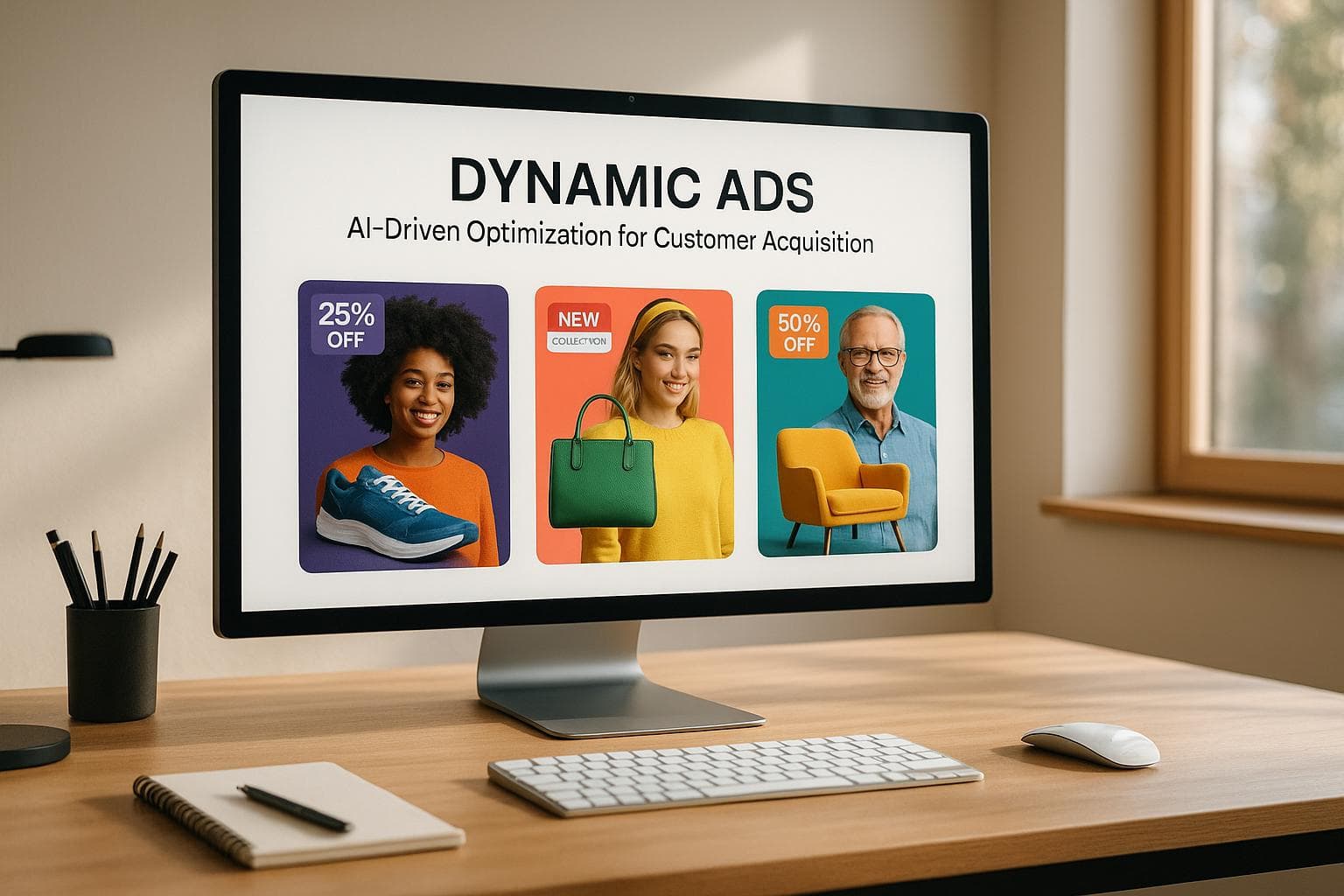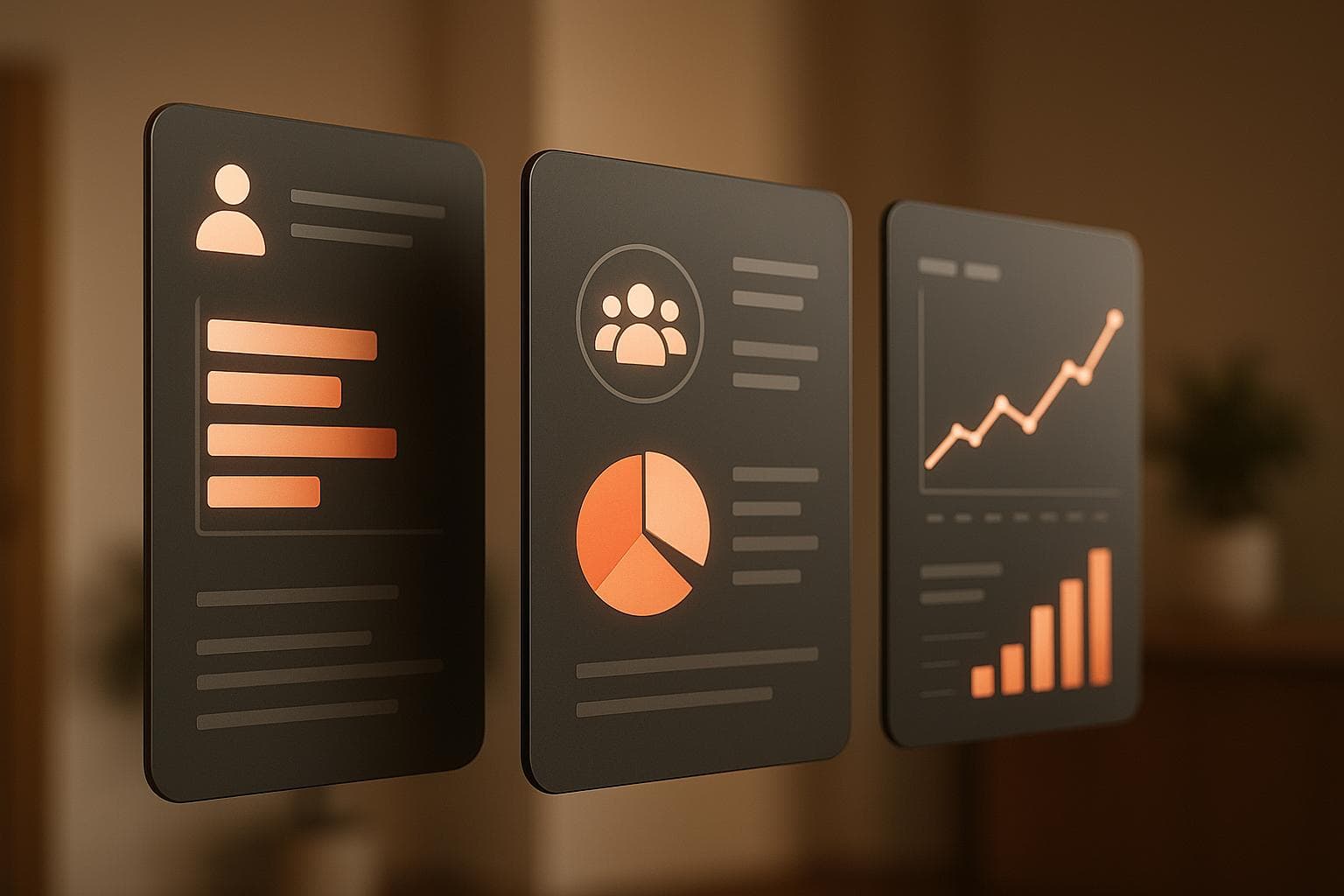AI-Powered Targeting for Facebook Ads ROI
Explore how AI is revolutionizing Facebook advertising with smart targeting, real-time optimization, and improved ROI strategies for e-commerce.
AI is transforming Facebook advertising by automating audience targeting, optimizing ad content, and improving campaign performance. Here's what you need to know:
- What it does: AI analyzes user data (like behavior, demographics, and engagement) to create precise audience segments and predict conversions.
- Key benefits: Lower costs (up to 30% reduction in CPA), higher returns (20–50% increase in ROAS), and smarter ad adjustments in real time.
- How it works: Techniques like predictive analytics, dynamic creative optimization (DCO), and automated budget allocation ensure ads reach the right people with the right message.
- Tools to simplify this: Platforms like Feedcast centralize campaign management, automate product data updates, and provide actionable analytics for better ROI.
How to Create the Best Facebook Ads with AI
Key AI Methods for Facebook Ad Targeting
Facebook's AI tools are reshaping how e-commerce businesses connect with their ideal customers. These advanced methods create a dynamic ecosystem that adjusts in real time based on user behavior and campaign performance.
AI-Driven Audience Segmentation
AI takes audience segmentation to the next level by analyzing thousands of data points to create precise micro-segments based on actual user behavior[1][2].
This involves sorting audiences into smaller, highly targeted groups using demographic details, psychographic trends, and behavioral signals. For instance, AI evaluates factors like user interactions, shopping habits, and time spent on specific pages. The result? Advertisers can deliver messages tailored to the unique preferences of each segment.
In Q2 2025, an e-commerce retailer showcased the power of AI-driven segmentation. By transitioning from manual targeting, they achieved a 35% boost in conversion rates and a 28% improvement in ROI. Their campaign relied on real-time updates, allowing the system to continually refine its targeting as user behavior shifted[1]. This level of precision lays the groundwork for the strategies that follow.
Predictive Analytics for High-Converting Audiences
Predictive analytics builds on segmentation by using historical data to anticipate future behavior. Facebook's AI studies past interactions, conversion triggers, and purchase patterns to identify users most likely to convert - often before they even see an ad[1][5].
By analyzing conversion paths of past customers - examining touchpoints like email opens, website visits, and social media activity - AI identifies new users with similar patterns and creates lookalike audiences. This method helps advertisers focus their budgets on prospects with the highest likelihood of converting.
For example, a US-based apparel store saw a 40% reduction in cost per acquisition (CPA) and a 25% rise in repeat purchases by implementing predictive analytics[5].
Dynamic Creative Optimization (DCO)
Dynamic Creative Optimization is where AI truly shines. DCO tests various ad elements - like headlines, images, and calls-to-action - and dynamically serves the best-performing combinations in real time[1][3].
This constant analysis ensures that each audience segment sees the most relevant and engaging ad. The result is higher engagement and better conversion rates, all without the need for manual adjustments by advertisers.
Automated Budget Allocation
AI simplifies budget management by monitoring campaign performance and reallocating funds in real time[1].
It evaluates key metrics like conversion rates, cost per acquisition, and return on ad spend across different audience segments and creative variations. When the system identifies high-performing segments, it automatically shifts more budget toward them, while reducing spend on underperforming areas.
This strategy ensures that every dollar is used efficiently. Advertisers using AI-driven budget allocation have reported ROI improvements of 20–40% compared to manual budget management methods[1][5].
AI-Powered Retargeting
AI-powered retargeting is a smarter way to re-engage past website visitors. Instead of showing the same ads to everyone, AI evaluates behavioral signals - such as purchase history, time spent on site, pages viewed, and previous ad interactions - to craft personalized strategies for each user[1][5].
For instance, someone who left items in their cart might be shown a special discount, while someone who only browsed might receive educational content about product features. AI also determines the best times to display these ads based on user engagement patterns.
These AI techniques thrive when paired with effective data management and unified campaign oversight. Tools like Feedcast simplify this process by automating product feed management, enriching product information, and offering smart audience segmentation tools that work seamlessly with Facebook's AI features[1].
Setting Up AI Tools for Facebook Ads
Getting the most out of AI targeting begins with a solid integration setup. Fortunately, if you're using platforms tailored for e-commerce, the process becomes much more manageable.
Requirements for AI Integration
Before diving into AI-powered targeting, there are a few essentials you'll need. At the core is Facebook Business Manager, which acts as your control center, and an active Facebook Ads account to manage your campaigns. Another must-have is the Facebook Pixel, a tracking code that monitors user behavior on your website and provides critical data to Facebook’s AI systems[4].
For even better tracking and compliance with data privacy rules, consider adding the Facebook Conversion API. Unlike the Pixel, this server-to-server connection ensures a more reliable data flow, especially as browsers tighten restrictions on tracking.
Your e-commerce platform also plays a role. Whether you’re using Shopify, WooCommerce, or Prestashop, make sure it can easily share product data with advertising platforms. For US-based businesses, configure your accounts to use USD currency and MM/DD/YYYY date formats for consistency across systems[4].
Lastly, ensure you implement user consent measures and have clear data usage policies to comply with regulations like CCPA. With these basics in place, integrating AI tools becomes a much smoother process.
Integrating Feedcast for Better Targeting
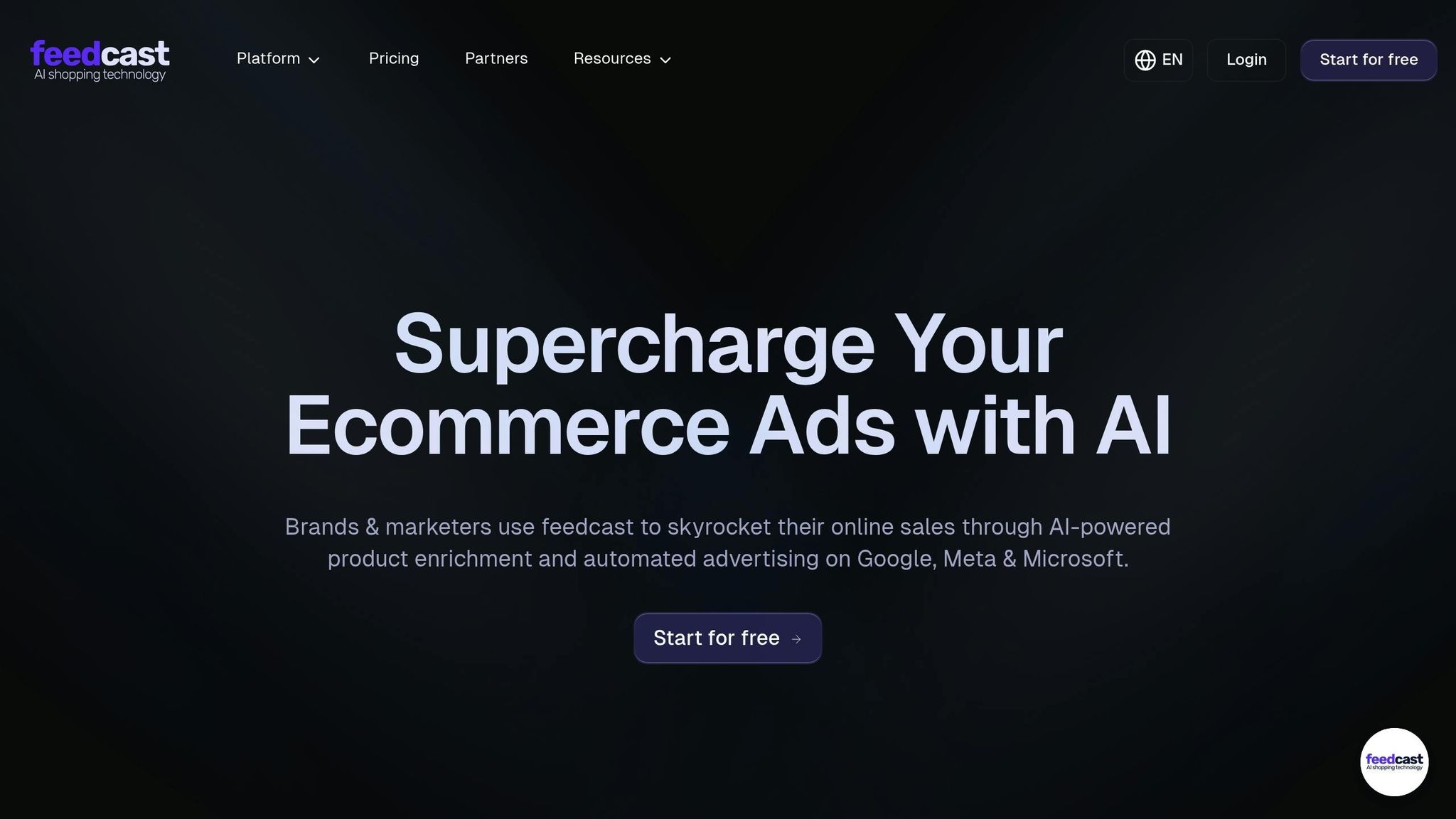
Feedcast simplifies Facebook Ads management by bringing everything into one user-friendly dashboard. By connecting your Facebook Ads account, you can oversee all campaigns in a single place.
The platform imports your product catalog from various sources, whether it’s your Shopify store, a CSV file, or Google Sheets. This centralized approach allows you to manage Facebook campaigns alongside Google and Microsoft Ads without switching between platforms.
Feedcast’s AI tools take it from there, using your product catalog and customer data to define targeting parameters and launch campaigns directly. You can also monitor real-time performance across all channels through Feedcast’s dashboard, making it easier to identify trends and fine-tune your strategy on the fly.
Automating Product Feed Management
Once your integration is set, automating your product feed is the next step to reducing manual work in AI-driven advertising. Feedcast’s AI continuously optimizes your product titles, descriptions, and attributes to improve how they appear in searches and increase relevance[4].
The system also identifies and fixes feed errors before they can disrupt your campaigns. When inventory changes or new products are added, Feedcast updates your data in real time across all connected channels.
But this goes beyond just fixing errors. The platform uses AI-powered enrichment to analyze trending search terms and update your product titles to match what customers are actively searching for. This keeps your ads competitive without requiring constant manual keyword research.
Feedcast also handles product segmentation automatically. Its AI identifies which products perform best with specific audience groups and creates targeted campaigns around those insights. This ensures your product feeds stay optimized even as market conditions shift.
For businesses managing large catalogs, this level of automation is a game-changer. Instead of manually updating hundreds or thousands of listings across multiple platforms, AI takes care of the heavy lifting, freeing you to focus on strategy and growth. Feedcast offers multiple pricing plans to fit different business needs: the Starter plan is free and includes unlimited products, product validation, and dashboard access. The Autopilot plan at $119/month adds 150 AI credits and supports one advertising channel, while the Premium plan at $299/month provides unlimited channel support and 500 AI credits.
sbb-itb-0bd1697
Best Practices for Maximizing ROI with AI Targeting
Once your AI tools are in place, the next big step is implementing them strategically to get the most out of your Facebook Ads.
Personalizing Ads at Scale
AI makes it possible to deliver personalized ads on a large scale. By analyzing a user’s browsing habits, purchase history, and engagement patterns, AI creates tailored ad variations that resonate with individual preferences. For instance, if someone frequently browses sportswear, AI can generate an ad showcasing your latest athletic gear. On the other hand, someone interested in tech might see an ad with gadgets and tech-focused messaging.
Tools like Feedcast use AI to enhance product data and create personalized ad copy for Facebook, all without the need for constant manual updates. Dynamic Creative Optimization (DCO) takes this a step further by adjusting ad elements in real time, which can significantly improve conversion rates. In fact, industry data shows that AI-powered Facebook campaigns can boost conversion rates by as much as 30% compared to traditional methods[1]. This level of personalization doesn’t just engage users - it directly impacts your ROI.
Continuous Audience Refinement
Personalization is important, but keeping your audience segments up-to-date is equally critical. AI excels at this by tracking real-time shifts in user behavior and adjusting audience segments as needed. By analyzing performance data, AI can uncover new trends, such as changes in demographic engagement or the emergence of new customer groups, and automatically refine targeting.
For example, AI can create distinct lookalike audiences based on specific patterns, like monthly premium product buyers versus occasional bargain shoppers. Feedcast’s dashboard makes this process simple by providing a clear view of audience performance across platforms like Facebook. It identifies underperforming segments and reallocates ad spend to focus on high-potential prospects. These real-time updates and adjustments can reduce wasted ad spend by up to 25%[1].
Using Real-Time Analytics for Quick Adjustments
Real-time analytics are a game changer for optimizing your ad campaigns. In digital advertising, speed is everything. AI-powered analytics provide instant feedback on key metrics, helping you make quick, informed adjustments to maximize ROI[1]. For instance, if an ad isn’t performing well, AI can suggest creative changes or reallocate your budget to better-performing ads - all within hours.
Feedcast’s centralized analytics dashboard offers a complete view of your campaign performance across platforms like Facebook, Google, and Microsoft Ads. This makes it easier to identify which audience segments are converting better and adjust your budget accordingly. Meta’s internal data shows that AI-powered ad recommendations often lead to higher engagement and better ROI[3]. Additionally, testing automated tools like Meta Advantage+ can uncover new optimization opportunities[2]. Facebook’s machine learning can identify audience segments and creative combinations that manual targeting might overlook, giving your campaigns an extra edge.
Measuring and Improving Facebook Ads ROI with AI
Make the most of your Facebook Ads by focusing on key metrics and leveraging AI to turn data into quick, actionable improvements.
Key Metrics for Measuring ROI
To effectively measure your Facebook Ads performance, you’ll want to track three critical metrics. The first is Return on Ad Spend (ROAS), which measures how much revenue you earn for every dollar spent on advertising. For example, a 4:1 ROAS means you’re making $4 for every $1 spent. Depending on your industry and campaign goals, ROAS benchmarks typically range between 4:1 and 10:1[1].
Next up is Cost Per Acquisition (CPA), which tells you how much it costs, on average, to acquire a new customer. This metric becomes even more impactful when AI is in the mix, as AI tools can optimize targeting and creative elements, potentially lowering CPA by up to 30%[1][5].
Lastly, there’s Click-Through Rate (CTR), a measure of how engaging your ads are to your audience. Higher CTRs often indicate that your targeting and ad creatives are hitting the mark, leading to better conversion rates and reduced costs. AI-driven campaigns often see improved CTRs thanks to more relevant content[1].
Now, let’s see how Feedcast takes these metrics and simplifies the process of tracking and improving them.
How Feedcast Simplifies Performance Tracking
Juggling performance data from multiple platforms can be a headache, but Feedcast’s unified dashboard makes it manageable. Instead of hopping between Facebook Ads Manager, Google Ads, and Microsoft Ads, you get a single, real-time view of all your metrics. Custom reporting tools pull together data from every channel, saving you time and effort.
Feedcast’s AI-powered analytics go a step further by identifying underperforming ads and suggesting optimizations. This reduces the manual work involved in maintaining profitable campaigns. The platform also allows you to segment performance data by product categories, audience groups, or geographic regions, helping you pinpoint exactly what’s working.
With Feedcast, you’re not just tracking metrics - you’re equipped to make immediate, informed adjustments. This centralized approach is especially useful if you’re running campaigns across multiple platforms like Facebook, Instagram, or Google Shopping. Instead of piecing together data from separate sources, Feedcast provides a complete picture of how your campaigns are driving ROI.
Continuous Optimization with AI Analytics
Once your performance tracking is dialed in, AI takes over to ensure your campaigns keep delivering results. The real strength of AI lies in its ability to learn and improve over time. It constantly monitors your ad performance and audience engagement, flagging areas that fall below your benchmarks for metrics like CTR or ROAS[1]. When something isn’t working, AI steps in to pause underperforming ads, reallocate budgets, or test new creatives.
This continuous learning process makes your campaigns smarter as they gather more data. AI can identify top-performing audience segments and shift budgets toward them while scaling back on less effective ones[1]. For instance, if AI notices that women aged 25–34 in urban areas are driving a higher ROAS for a specific product, it will prioritize that group while reducing spend on lower-performing segments.
AI also builds more accurate lookalike audiences using data from your existing customers, increasing the likelihood of conversions[5]. Facebook’s machine learning can create highly targeted micro-segments based on factors like hobbies, demographics, and real-time behaviors, delivering ads that feel tailored to individual users[1]. This level of precision would be nearly impossible to achieve manually, but with AI, it happens automatically.
In today’s fast-paced digital world, real-time adjustments are essential. If AI detects a sudden rise in CPA or a drop in conversion rates, it can instantly tweak targeting, creative, or budget allocation to minimize losses and capitalize on new opportunities. This proactive approach ensures that every advertising dollar is working as hard as possible.
Conclusion: Improving Facebook Ads ROI with AI
AI has transformed the way e-commerce businesses approach Facebook advertising, moving from manual targeting to precise, automated systems that deliver measurable returns. This shift has redefined how businesses can make the most of their ad budgets.
By adopting the strategies discussed in this guide, e-commerce retailers using AI-driven Facebook ad targeting have seen noticeable improvements in metrics like ROAS and CPA. Tools like Feedcast illustrate this evolution by combining key AI capabilities in one platform. With AI-powered product enrichment, your Facebook ads can highlight the most persuasive product details, while smart targeting ensures you connect with the audiences most likely to convert.
What sets AI apart in Facebook advertising is its ability to learn and adapt continuously. Unlike traditional campaigns that demand constant manual adjustments, AI systems refine targeting, optimize creative elements, and adjust budgets based on real-time performance data. This ongoing improvement makes campaigns smarter over time, enhancing ROI without requiring extra effort from advertisers.
Additionally, platforms like Feedcast streamline campaign management across multiple channels. Instead of navigating Facebook Ads Manager alongside other tools, you get a single dashboard offering comprehensive insights and full control. This unified approach not only saves time but also empowers businesses to make strategic decisions based on complete performance data.
To fully unlock the potential of AI-powered Facebook advertising, businesses should focus on automating audience segmentation, dynamic creative optimization, and real-time analytics. The combination of AI precision and platform automation provides a competitive edge that directly improves ROI and supports long-term growth.
The future of Facebook advertising lies with businesses that can leverage AI to deliver the right message to the right audience at the right time. Platforms like Feedcast make that future achievable today.
FAQs
How does AI make Facebook Ads audience targeting more effective?
AI enhances Facebook Ads audience targeting by leveraging advanced algorithms to study user behavior and preferences. This means businesses can craft tailored ad content and apply intelligent targeting methods to connect with the most relevant audience at the perfect moment.
Additionally, AI enables businesses to retarget their existing customers with greater precision, strengthening customer loyalty, attracting new buyers, and optimizing their return on investment (ROI).
How does Feedcast help improve ROI for Facebook Ads with AI tools?
Feedcast.ai empowers e-commerce businesses to get more out of their Facebook Ads by using AI-driven tools that make advertising simpler and more effective. With its advanced technology, it crafts personalized ad copy and applies smart targeting strategies to ensure your ads connect with the right audience.
What’s more, Feedcast.ai provides a single platform to manage campaigns across multiple channels, like Facebook and Instagram, making ad management much easier. By automating essential tasks and fine-tuning audience targeting, it helps businesses achieve better results with less hassle.
How can businesses use AI tools for Facebook advertising while staying compliant with data privacy regulations?
To ensure compliance with data privacy regulations when leveraging AI tools for Facebook advertising, businesses need to focus on both transparency and security. Clearly communicate to users how their data will be collected and used, and make sure to obtain any necessary consent based on applicable laws. Depending on your audience's location, this might mean adhering to regulations like the GDPR in Europe or the CCPA in California.
It's also essential to regularly evaluate your data practices. Avoid collecting unnecessary personal information, and choose AI platforms that emphasize strong privacy protections and advanced security features. This approach allows you to take advantage of AI-driven targeting while safeguarding user trust and meeting legal requirements.
Yohann B.
